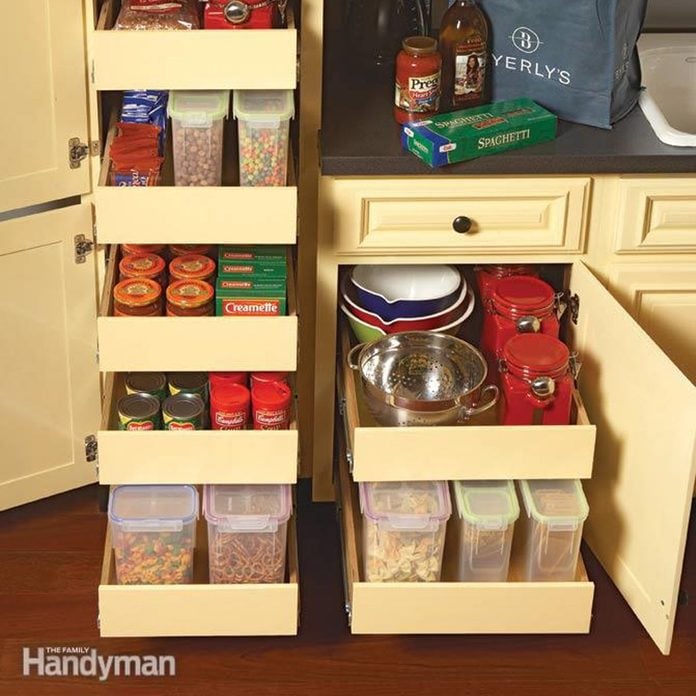
Benefits of Pull-Out Cabinet Organizers
It may sound like hype, but adding pull-out drawers, or rollouts, to your kitchen cabinets can be life-changing. I speak from personal experience. I recently added pull-out cabinet organizers to our entire kitchen, and this is what happened:
- The kids have complete access to everything they need — from cereal to the recycling. Now they can get their own breakfast and take the cans to the curb — no excuses!
- My sore back and my husband’s bum knee are less of an issue since we no longer have to constantly stoop to find things in our base cabinets.
- Dinner prep goes a lot faster now that we’re not hunting for pot lids and baking pans piled on top of one another on our jumbled, dark shelves.
- We’re saving money by not buying things we already have (but that had been lost in the recesses of our cabinets). We can pull our shelves into the light and see everything, including the rancid oil and three boxes of cornstarch we somehow acquired.
- The kitchen feels larger and works better. The rollouts maximize every cubic inch of kitchen storage space, so I can store rarely used appliances in my cabinets instead of on my counters.
This article will give you tips for planning, buying and building pull-out cabinet organizers so they can change your life too. You can build a simple rollout drawer like the ones shown in a couple of hours for $20. But don’t say I didn’t warn you. Once you see that rollout in action, you’ll want to retrofit all your kitchen cabinets. What are you waiting for?
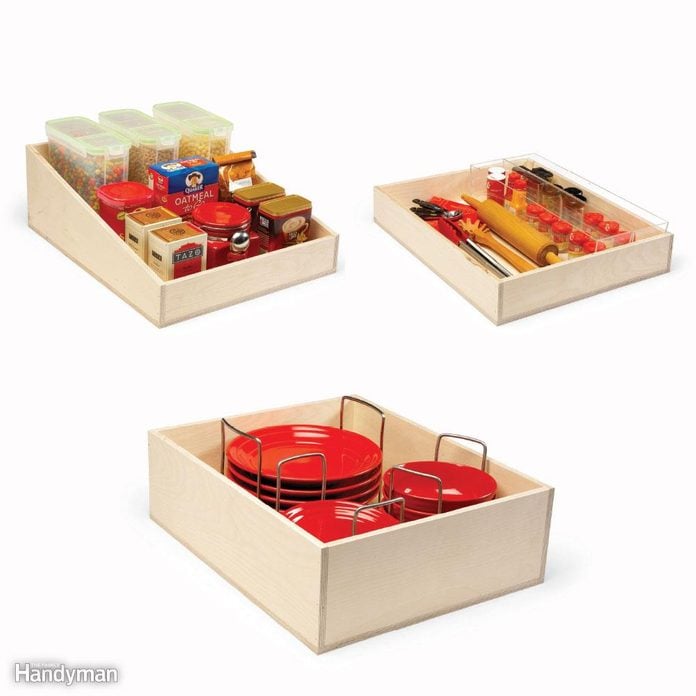
Custom Pull-Out Drawer Boxes
Building a slew of identical drawer boxes is easier, but having a variety gives you more versatility. Think about what you’re going to store and build the boxes to suit your kitchen organizing needs.
Sloping sides: Rollout drawers with sloping sides keep tall things stable yet still let you see all the way to the back of the shelf. These are good for nesting pots and pans or storing different-size items on the same shelf.
Low sides: Lower sides (3 in. is typical) work well for smaller items such as canned goods and spices. The low sides make reading labels easier.
High sides: Shelves with higher sides all around (6 in. tall rather than the typical 3 in.) are ideal for tippy plastic storage containers or stacks of plates.
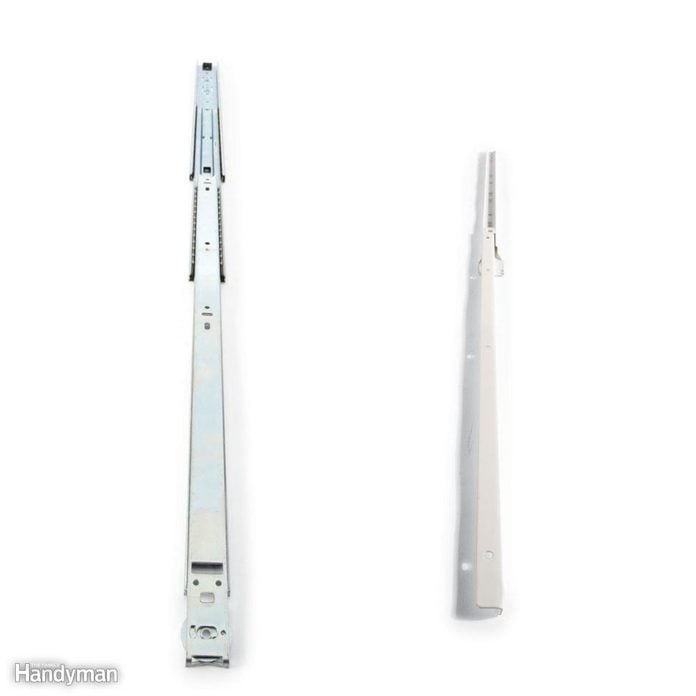
Use the Right Slides
There are a dozen kinds of drawer slides out there, but if you want to keep shopping and installation simple, stick to these two types:
Roller slides glide on plastic wheels. They’re inexpensive, a cinch to install (it takes about two minutes) and nearly impossible to mess up. You’ll find them at home centers under various names including side mount, under mount and bottom mount. Most are rated to carry 35 to 100 lbs. For heavy-duty pull-out cabinet organizers holding items such as canned goods, use slides rated for at least 100 lbs. The big disadvantage: Most roller slides extend only three-quarters of their length — the back of the drawer stays in the cabinet.
Ball-bearing slides glide on tiny bearings. The big advantage of these slides is that they extend fully, giving you complete access to everything in the drawer. They’re about three times the cost of roller slides, and they’re usually rated to carry 75 to 100 lbs., but you can get 200-lb. versions for about $40 a pair. Home centers carry ball-bearing slides, but you’ll find a wider variety at woodworkershardware.com. The big disadvantage: They’re fussy to install. If your drawer is a hair too big or small, these slides won’t glide.
Tip: Make drawer boxes about 1/32 in. smaller than you need. It’s easy to shim behind a slide with layers of masking tape to make up for a too-small drawer. It’s a lot harder to deal with a drawer that’s too wide.
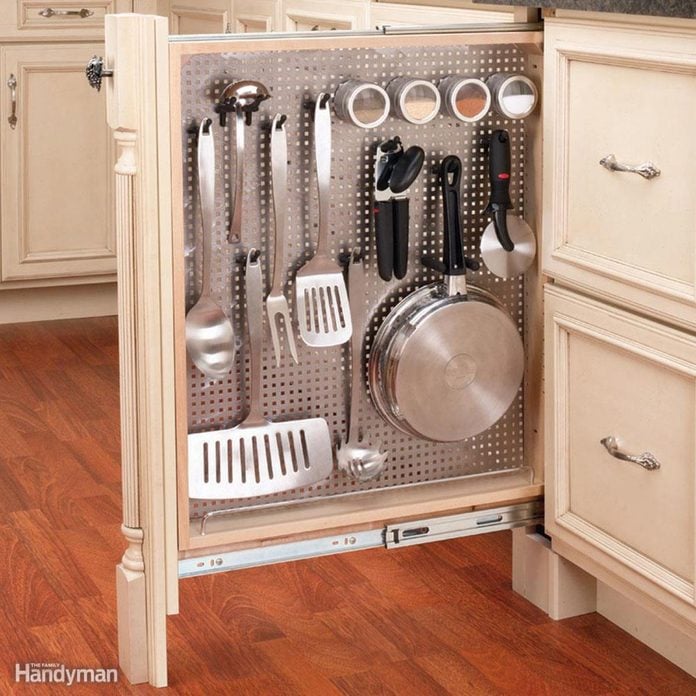
Pull-Out Cabinet Organizers for Skinny Spaces
In a small kitchen with little storage space, you can make even narrow filler spaces work harder by installing a vertical pegboard rollout. Kitchen designer Mary Jane Pappas typically recommends 18- to 30-in.-wide rollout drawers for cabinets: ‘Any larger and they’re too clumsy. Any smaller and too much of the space is used by the rollouts themselves.’
But there is one type of rollout that makes good use of narrow spaces, even those only 3 to 6 in. wide. Pappas says that pullout pantries– single tall, narrow drawers with long, shelves, drawers, baskets or even pegboard – can be an efficient way to put skinny spaces to work.
Shown is the 434 Series 6-in. Base Filler with stainless steel panel from Rev-a-Shelf, the perfect pull out drawers for cabinets.
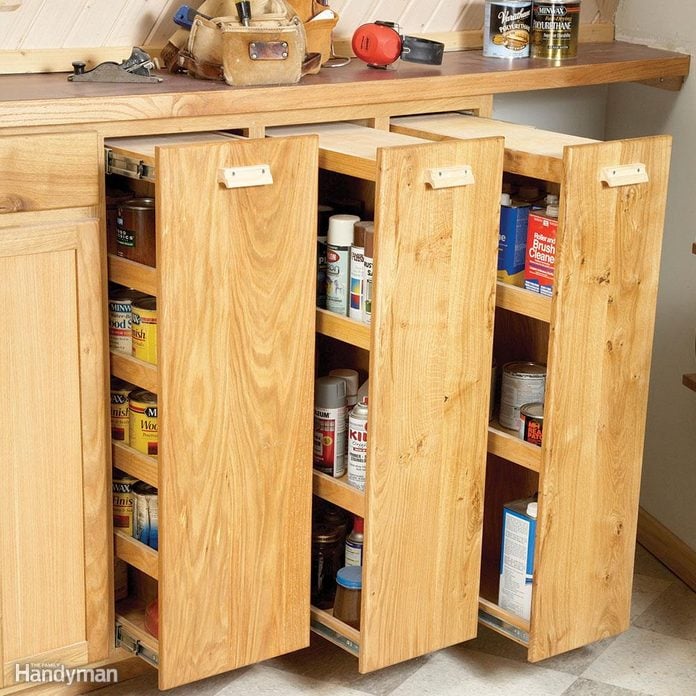
Start With Lower Pull-Out Cabinet Organizers
The most useful rollout shelves and drawers are the ones closest to the floor since these eliminate the most awkward bending and crouching. If want to limit your time and money investment, you’ll get the most bang for your buck by retrofitting these areas first with slide out cabinet shelves. You can even build under-cabinet drawers for your base cabinets.
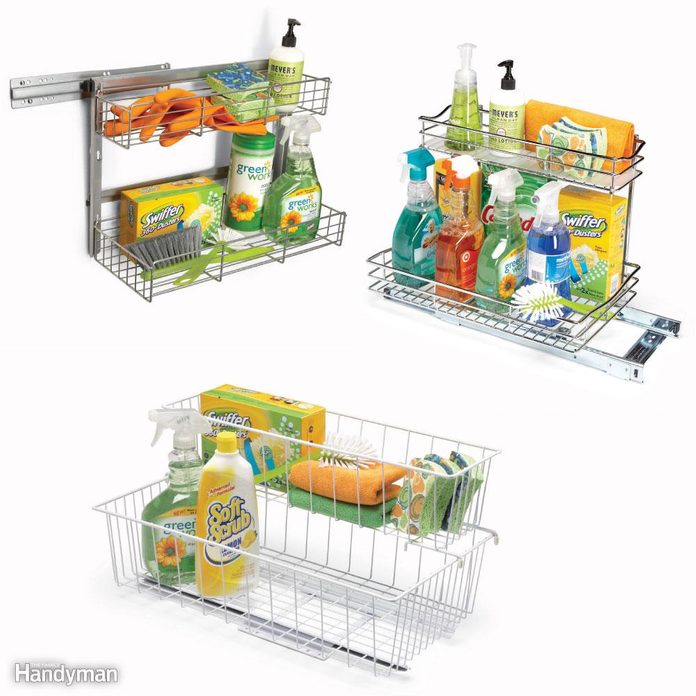
How To Choose Store-Bought Pull-Out Cabinet Organizers
You can spend as little as $10 for a simple wire rollout basket or as much as $100. So what’s the difference? Look for rollouts with quality hardware. Second-rate slides and rollers can sag or seize up under sacks of flour and pots and pans. Examine the slides to check whether they’re roller slides (which extend only three-quarters of their length) or ball-bearing (which extend fully).
Ball-bearing slides tend to support heavier items and let drawers roll more smoothly. Choose sturdy, chrome-plated steel rollouts for heavier items. Steel rollouts come in different gauge metals. Before ordering online, shop around at different retailers so you can physically compare the weight and density of the steel used by different manufacturers.
Epoxy-coated wire rollouts and plastic inserts work fine for light-duty items, but they have a tendency to crack, bend and scratch if packed with heavy loads like canned goods.
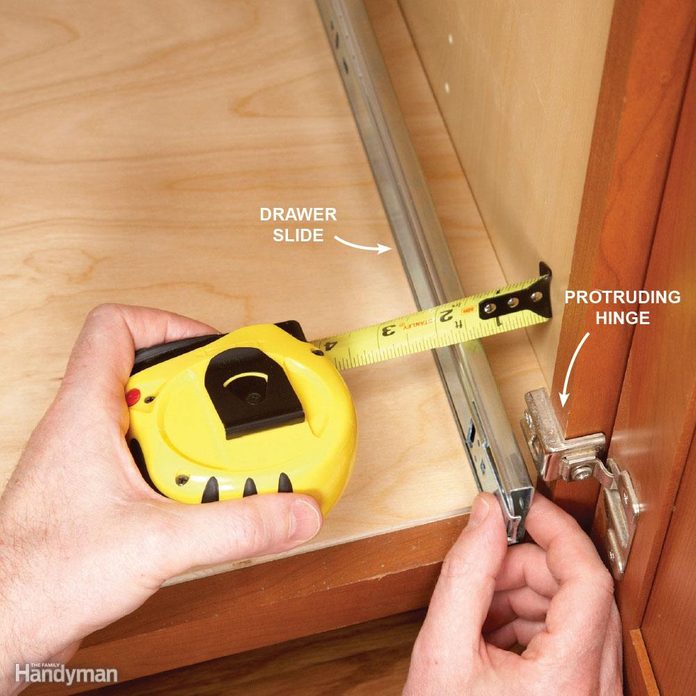
Watch for Obstacles
Every cabinetmaker has a story about the rollout that wouldn’t roll out but instead collided with something. When you’re measuring for the spacer width, watch out for protruding hinges and doors that don’t open fully or that protrude into the cabinet opening.
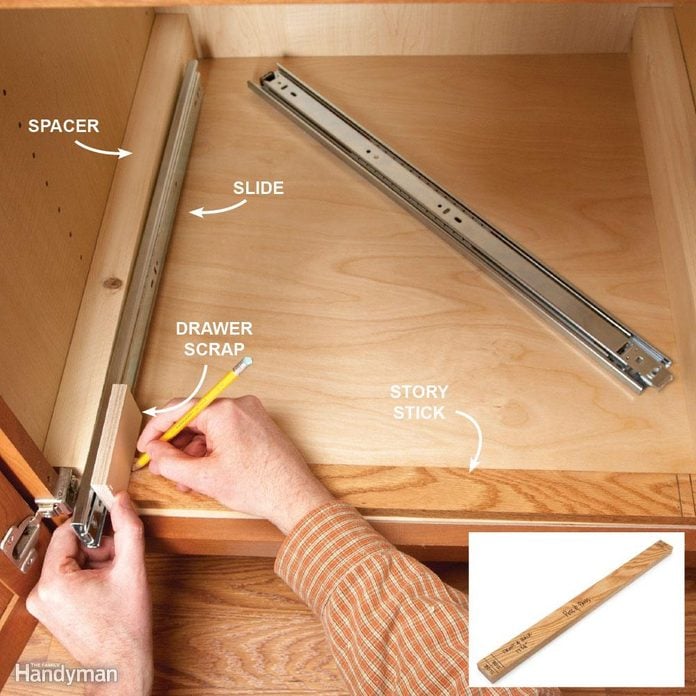
Avoid Mistakes With a Story Stick
The most obvious way to size rollout parts is to measure the opening of the cabinet and then do the math. But that’s a recipe for mistakes because it’s easy to forget to subtract one of the components (like the width of the slides or the drawers) from the overall measurement.
So try this: Forget the math and mark your measurements on a piece of scrap wood. It’s a great visual aid that helps you prevent mistakes and having to walk between your kitchen and your shop constantly to double-check measurements.
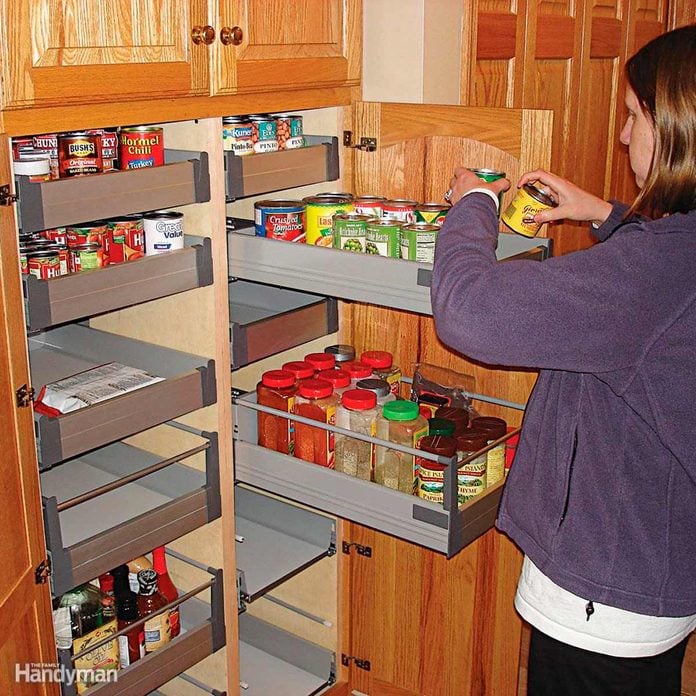
Divide Up Wide Spaces
If the cabinet is more than 30 in. wide, consider installing two narrower rollouts side by side rather than a single wide one. This means some extra building work and buying more slides, but the smaller rollouts will operate more smoothly and easily.
Wider shelves and drawers tend to bind or rack as you slide them in and out. Adding a divider creates 12 handy rollouts instead of six big awkward ones. Here’s how you can make your own DIY drawer dividers.
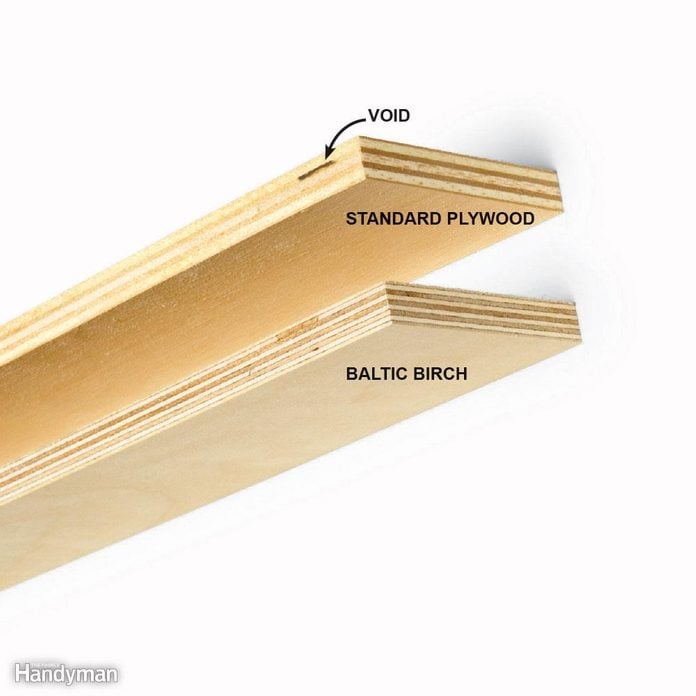
Baltic Birch Pull-Out Cabinet Organizers
Cabinetmakers love Baltic birch plywood for rollouts because the edges look great. Unlike standard hardwood plywood, Baltic birch never has voids in the inner core. It may not be labeled ‘Baltic birch’ at home centers, but you’ll be able to identify it by comparing it with other hardwood plywood in the racks. It’ll have more and thinner laminations in the plywood core.
The biggest disadvantages of using Baltic birch are that it costs more than standard hardwood plywood and can be harder to find. A 4 x 8-ft. sheet will run you $65 compared with $50 for standard hardwood plywood. If your home center doesn’t carry it, try a traditional lumberyard.
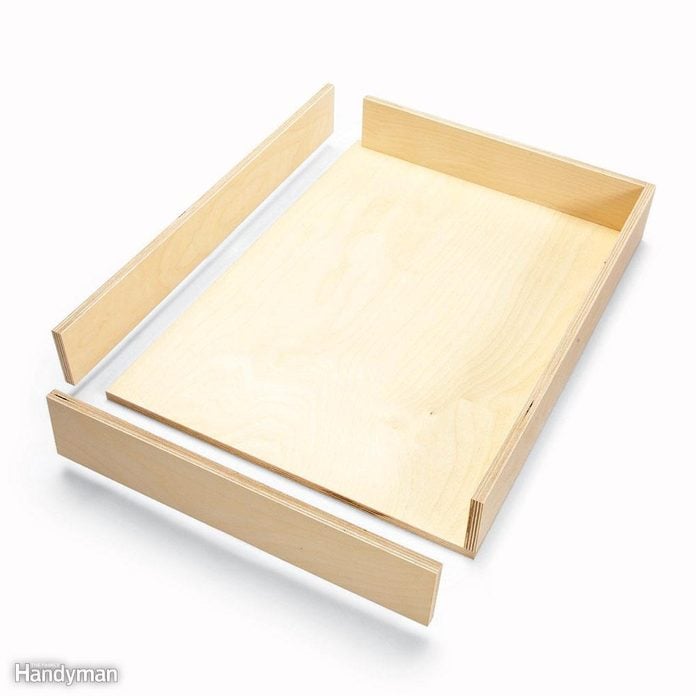
Keep Drawer Boxes Simple
All the drawer boxes in your kitchen or workshop can be kept super-simple: with butt-joint corners and glued-on bottoms. No rabbets, dadoes or dovetails. They won’t look very impressive, but they’ll hold up for years. If simple boxes can carry tools and hardware, we figure they can stand up to kitchen use, too.
Consider having drawer boxes made to your exact specs and then install them yourself. Compared with buying material and finishing it yourself — not to mention the dovetail joints — you can’t beat it. And it looks much nicer.
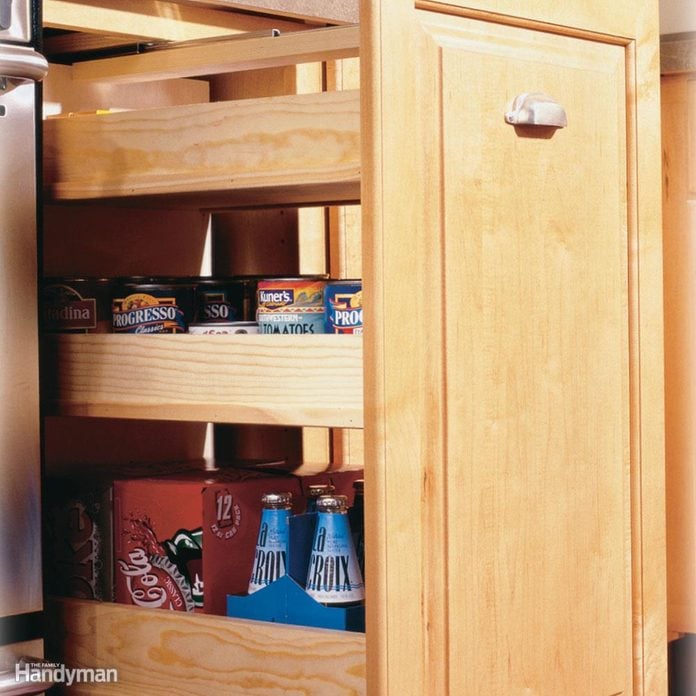
Build a Pantry Pull-Out Cabinet Organizer
Most cabinet manufacturers now include roll-out shelves in their base cabinets. But if you don’t have this convenience, this project will explain how to build your own lower cabinet rollouts. Here we’ll show you how to make an entire roll-out pantry. The hardware consists of two heavy-duty bottom-mounted slides and one center-mounted top slide that together can support 130 lbs. Again, construct your unit to suit your needs.
We made our bottom tray 3-1/2 in. tall and the upper ones 2-1/2 in. tall. You may want to include only two trays if you’ll be storing cereal boxes and other tall packages. Since you’ll be converting your door from swinging to rolling mode, you’ll need to remove the door and hinges. You’ll also have to remove the existing handle and reinstall it centered on the door. If your hardware mounts from the backside, install it before attaching the door.
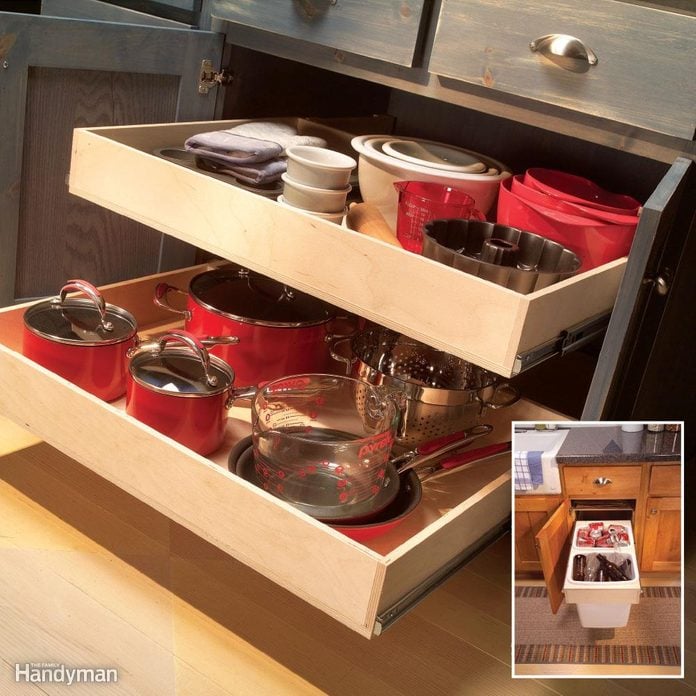
Build Classic Rollouts Plus a Trash Center
Base cabinets have the least convenient storage in your kitchen. We’ll show you how to bring everything in your cabinets within easy reach by retrofitting your base cabinets with classic rollout shelves. This tutorial shows how to construct a special rollout for recycling and trash without using expensive bottom-mount hardware. Keep garbage out of sight with a pull-out trash can.
Get step-by-step instructions for measuring, building the rollout drawer and its carrier, attaching the drawer slides, and mounting the unit in the cabinet.
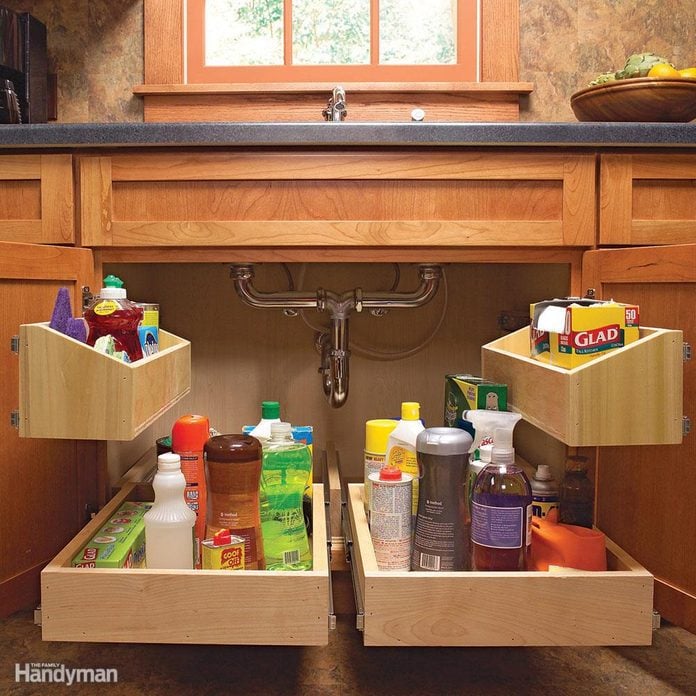
Under-Sink Cabinet Pull-Out Organizers
The space under sinks is often overlooked, but it’s prime real estate for rollouts. You can build your own under-sink organizer with two types of customizable rollout trays that fit around and below plumbing pipes, garbage disposals and other obstacles beneath your sink.
These rollouts transform that ‘I’m not sure what’s under there’ storage space into an organized and efficient location for cleaning supplies that lets you see everything you’ve got in one glance. Take a look at these under sink organizers, too.
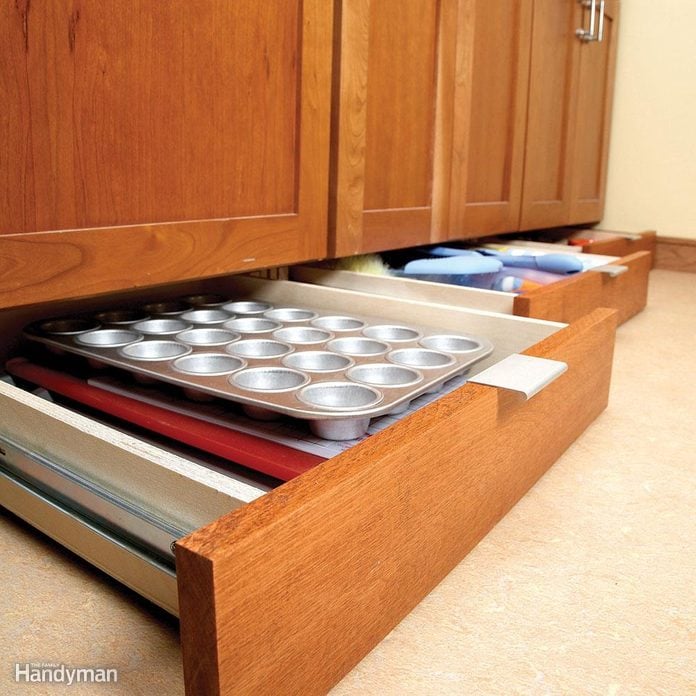
Build Rollouts at Ankle Level
Turn wasted toe-kick cavities into clever flat storage space for serving trays, cutting boards and baking pans. This article shows you how to construct under-cabinet rollouts that you assemble in your shop and then just slip into place beneath your existing cabinets.
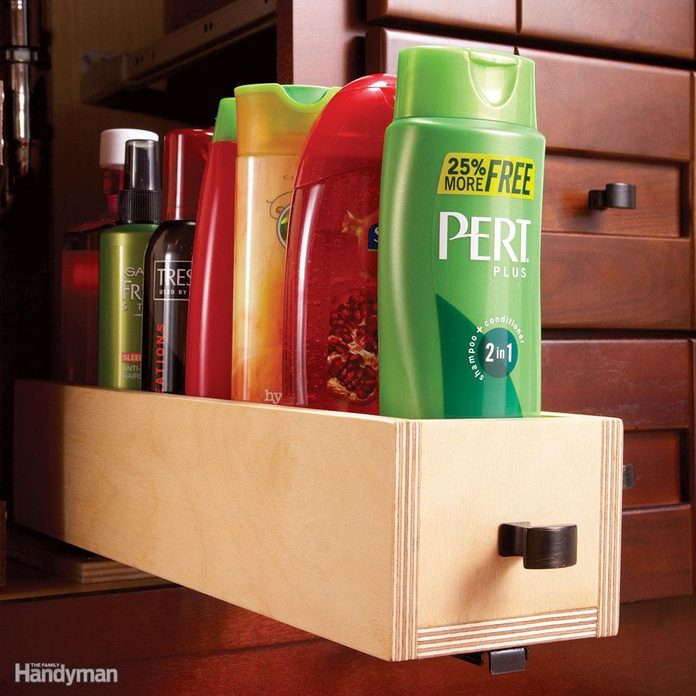
Build a Mini Bathroom Cabinet Rollout
No more tipping! This handy little rollout has tall sides, fronts and backs to keep bottles and cleaners in place as you open it. Here’s how to make this bathroom vanity upgrade for your bathroom cabinet.
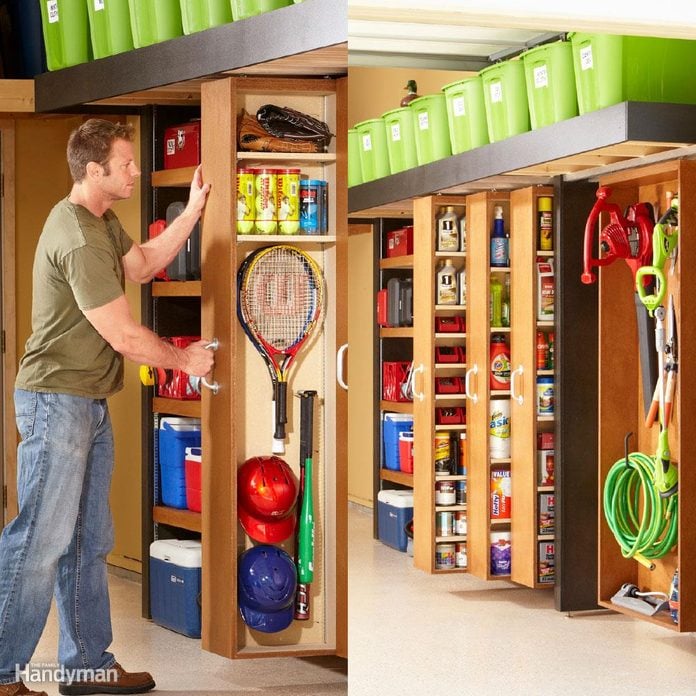
Garage Pull-Out Storage Shelves
Let’s face it. No matter how big your garage is, there never seems to be enough room to store everything. But this storage project makes ultra-efficient use of the narrow area on the sidewall of your garage.
The heart of the system is a series of double-sided rollout shelves that allow easy access to everything that can be stored in a narrow space. With these rollouts, you don’t have to store your paint cans, nails, screws and other stuff four layers deep and then shuffle everything around to find what you’re looking for. When the shelves are pulled out, everything is in full view and easily accessible. Plus, the garage looks neat and tidy when the shelves are pushed back in.
Don’t worry if you’ve also got some large items to store. The 16-ft.-long top shelf is 32 in. deep to hold big storage containers, and there’s a 3-ft.-wide section of 16-in.-deep shelves for medium-size items. The storage unit is 16 ft. long, 84 in. tall and 16 in. deep. The best part? You can make these pull-out garage shelves yourself.